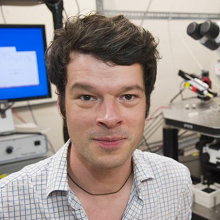Prof. Dr. Alexander Groh, Medical Biophysics – Institute of Physiology and Pathophysiology – Heidelberg University – Medizinische Fakultät Heidelberg
GT Conférences CRNL

Abstract: Neuronal bursts are high-frequency firing patterns widely observed in brain circuits and often linked to cell intrinsic properties and behavioral state. We investigated neuronal activity patterns in simultaneously recorded thalamocortical brain regions of freely moving mice as they learned to discriminate sensory stimuli using their whiskers. During learning, populations of neurons emerged across cortical, thalamic, and extrathalamic regions, encoding stimulus-reward contingencies through the presence or absence of bursts. These burst-coding neurons (BCNs) increased in number with task acquisition and BCN burstiness scaled with stimulus valence rather than physical stimulus identity. BCNs dynamically tracked stimulus-reward contingencies across multiple rule reversals, and burst coding dissipated upon contingency degradation. These findings provide direct evidence that neuronal bursts encode reward contingencies, positioning bursts as context encoders and teaching signals in associative memory formation.
Research focus: Neuronal circuit function, neurophysiology, thalamocortical circuits, synaptic physiology, neuronal mechanisms of pain, electrophysiology, optogenetics
CRNL | CH Le Vinatier | Bâtiment 462 Neurocampus Michel Jouvet | Amphithéâtre | 95 Boulevard Pinel | 69500 Bron











